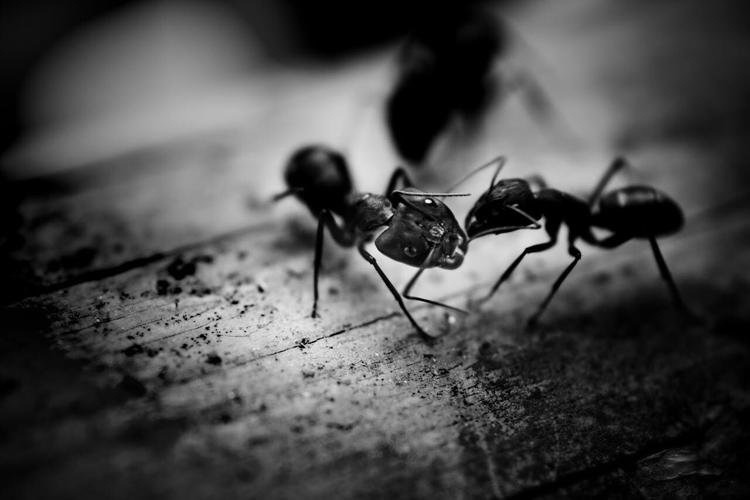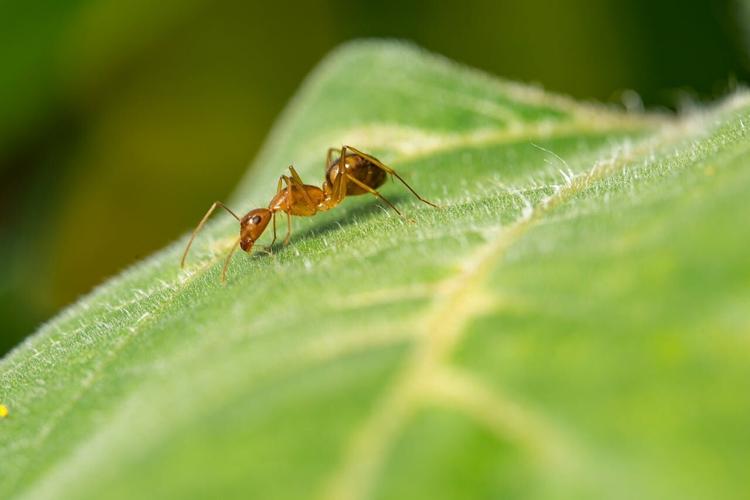
In this photo, the parasitic ant queen Lasius orientalis (left) infiltrates the nest of Lasius flavus and apporaches their queen (right). The parasite will then spray the host queen and trick the colony to attacking their own mother. Once the host queen is dispatched, the parasitic queen will take over. (Kyushu University via SWNS)
By Stephen Beech
Ants use 'chemical warfare' to compel host workers to kill their own queen, reveals new research.
Scientists have observed for the first time an invading ant queen using a chemical spray to compel host workers into murdering their own mother.
They explained that in the ruthless world of parasitic ants, taking over a host colony is a matter of life and death.
The conventional understanding had been that an invading queen must physically fight and kill the resident queen to seize control.
But the new study, published in the journal Current Biology, details a more "sinister" strategy - a parasitic ant queen that chemically manipulates the host colony’s workers into executing their own mother.
Corresponding author Assistant Professor Keizo Takasuka, of Kyushu University in Japan, said: “The initial discovery was made by my friend Taku Shimada, the first author of the paper, who has been passionate about ants since childhood and runs a popular blog called ‘AntRoom.’
"He observed the colony infiltration and posted about it in 2021.

(Photo by Syed Rajeeb via Pexels)
“I found the post three years later and was so astonished.
"I thought it was a very valuable discovery that deserved to be documented as academic knowledge.”
He says the chemical manipulation was documented in two distantly related species of parasitic ants and their hosts: Lasius orientalis, which infiltrates the nests of Lasius flavus; and Lasius umbratus, which invades the colonies of Lasius japonicus.
Dr. Takasuka said: “The parasitic behavior of the latter species of ants was discovered by Yuji Tanaka, who is the second author of this study.
"He is another enthusiastic amateur of ants and followed the same observational methods established by Shimada,”
In the case of Lasius orientalis, he says the parasite sprayed the host colony queen repeatedly, about 15 times over 20 hours.
That slowly agitated the host workers, who began attacking their queen, eventually mutilating and killing her after four days.
But the Lasius umbratus queen used only two targeted sprays.
The researchers said that it was enough to incite an "immediate and fatal attack" from the host workers, who proceeded to dismember their queen.

(Photo by Heather Smith via Pexels)
In both cases, after the matricide, the host workers accepted the parasitic queen, who soon began laying her own eggs to be cared for by the orphaned colony.
The research team suggests the fluid was formic acid - a well-known defensive compound used by many ant species to deter predators or as a warning signal to fellow nestmates.
In that context, they say it appears to act as a "deceptive" social signal.
Dr. Takasuka said: “In both cases, the host and parasite belong to the same genus, so they both have formic acid and recognize it as a danger signal.
“We believe that when their queen is suddenly covered in a large amount of this chemical, the workers perceive their own mother as a colony-threatening crisis which triggers their aggressive defensive behavior.”
To get close enough to perform the manipulation, the parasite must first bypass the colony’s guards.
The researchers replicated that step in their experiments through a process called host-odour pre-acquisition.

(Photo by Jimmy Chan via Pexels)
Dr. Takasuka said: “Direct infiltration would fail because the workers would immediately perceive the intruder and attack her.
“To achieve this, the parasitic queen was housed with a few host workers and cocoons.
"After just one night, she acquired the host colony’s specific scent, providing a chemical camouflage that was essential for her to get past the initial defences.”
Even though the two parasitic ant species are not close relatives, the researchers say they share the same genus that is known to have two discrete origins of social parasitism.
Dr. Takasuka explains that the behaviors are an example of "convergent evolution" - where similar traits develop independently between unrelated species.
He said: “My own research focuses on how parasitoid wasps manipulate the behavior of spiders, so I know that in the natural world, parasitic organisms utilize many various and interesting strategies to infect their hosts.
“This discovery in ants is another fascinating example."
Dr. Takasuka added: "I am interested in investigating these different host-killing strategies to understand the evolutionary pressures that drive them.”
























(0) comments
Welcome to the discussion.
Log In
Keep it Clean. Please avoid obscene, vulgar, lewd, racist or sexually-oriented language.
PLEASE TURN OFF YOUR CAPS LOCK.
Don't Threaten. Threats of harming another person will not be tolerated.
Be Truthful. Don't knowingly lie about anyone or anything.
Be Nice. No racism, sexism or any sort of -ism that is degrading to another person.
Be Proactive. Use the 'Report' link on each comment to let us know of abusive posts.
Share with Us. We'd love to hear eyewitness accounts, the history behind an article.